The online education industry has been making strides since the pandemic times. eLearning has helped people to become a better version and upskill themselves during challenging situations. Thanks to platforms like Udemy, Coursera, Google Classroom, etc., which have brought a positive change, leading to a greater interest of students and teachers in customized learning opportunities.
As per the insights of the global market, the eLearning sector is going to cross the mark of one trillion USD by the end of 2027. Remarkably, the growth of the eLearning market has been quite exponential in a pretty short term.
With a marketplace of over 40 million subscribers, 70,000 instructors, and 157,000 courses, Udemy has come a long in the field of eLearning. The cloud-based learning management system is doing great in terms of both – inspiring young talents and inviting business owners to invest and launch their own eLearning platforms.
If you are already interested in and have with a mind-blowing idea of developing such an eLearning app, then why wait? It’s the time time to soak in some useful insights about eLearning app development.
What is an eLearning portal?
Simply put, eLearning portals transform learning and development strategies by providing easy access to educational resources and skill development opportunities. They enhance engagement, effectiveness, and impact by offering flexible learning options personalized to individual needs. At the enterprise level, eLearning facilitates continuous upskilling and knowledge refinement, enhancing customer service and satisfaction.
Many Fortune 500 companies heavily rely on eLearning, saving significant costs compared to traditional learning methods. These portals, typically integrated with a learning management system, offer multimedia-rich content, interactive features, and personalized learning experiences for various types of learners, fostering a culture of continuous learning and improvement.
In eLearning platforms, various types of learning portals can be identified:
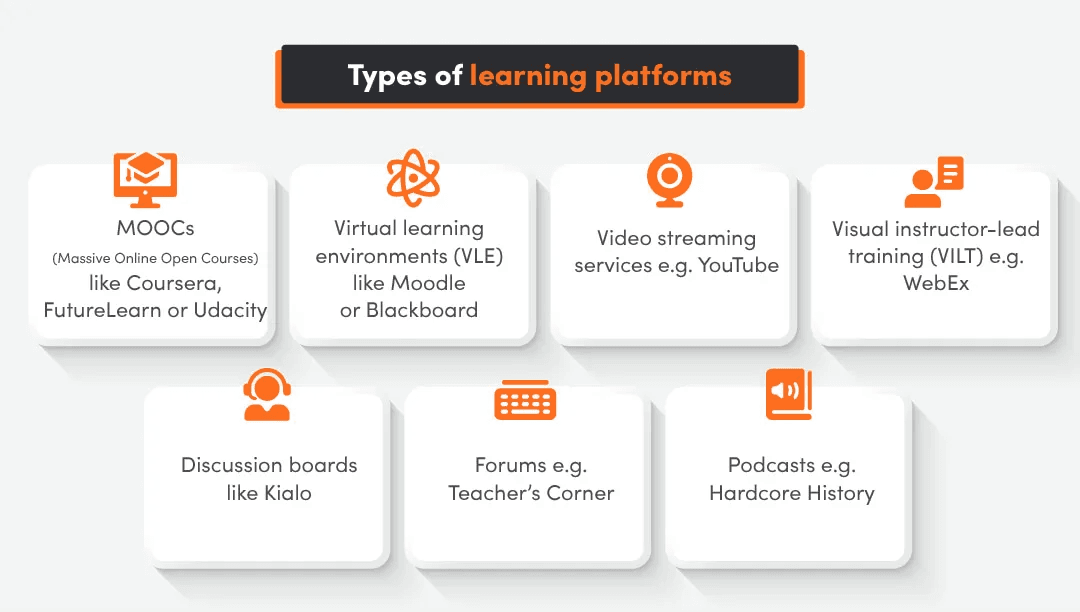
What is Udemy?
The Udemy training and eLearning app offers a wide range of skills-based, educational, and vocational courses for trainees. With over 40,000 books from academic professors, Udemy aims to provide a personalized and comprehensive learning experience.
Accessible across various devices including iOS, Android, laptops/desktops, and even Apple TVs, Udemy stands out as a versatile platform. Its popularity continues to grow, inspiring more businesses and developers to create similar eLearning apps.
With around thirty percent of higher education students in the US participating in distance learning courses, platforms like Udemy offer valuable opportunities to deepen knowledge and expand skill sets.
How does an eLearning platform like Udemy works?
- Users register as teachers or learners on the platform.
- Teachers create online courses, which are listed for learners to get enrolled.
- When a learner purchases a course, the payment is transferred to the teacher after deducting a commission for the website.
- Additionally, the website offers course completion certificates for certain courses, serving as an additional source of revenue.
This straightforward model enables the platform to connect educators with learners, facilitating the exchange of knowledge and skills.
Business Model
- Udemy affordability: One of the most affordable platforms compared to competitors.
- Language diversity: Offers courses in 77 languages, enhancing global accessibility.
- User base: 85 million learners enrolled on Udemy, indicating high-quality content and popularity.
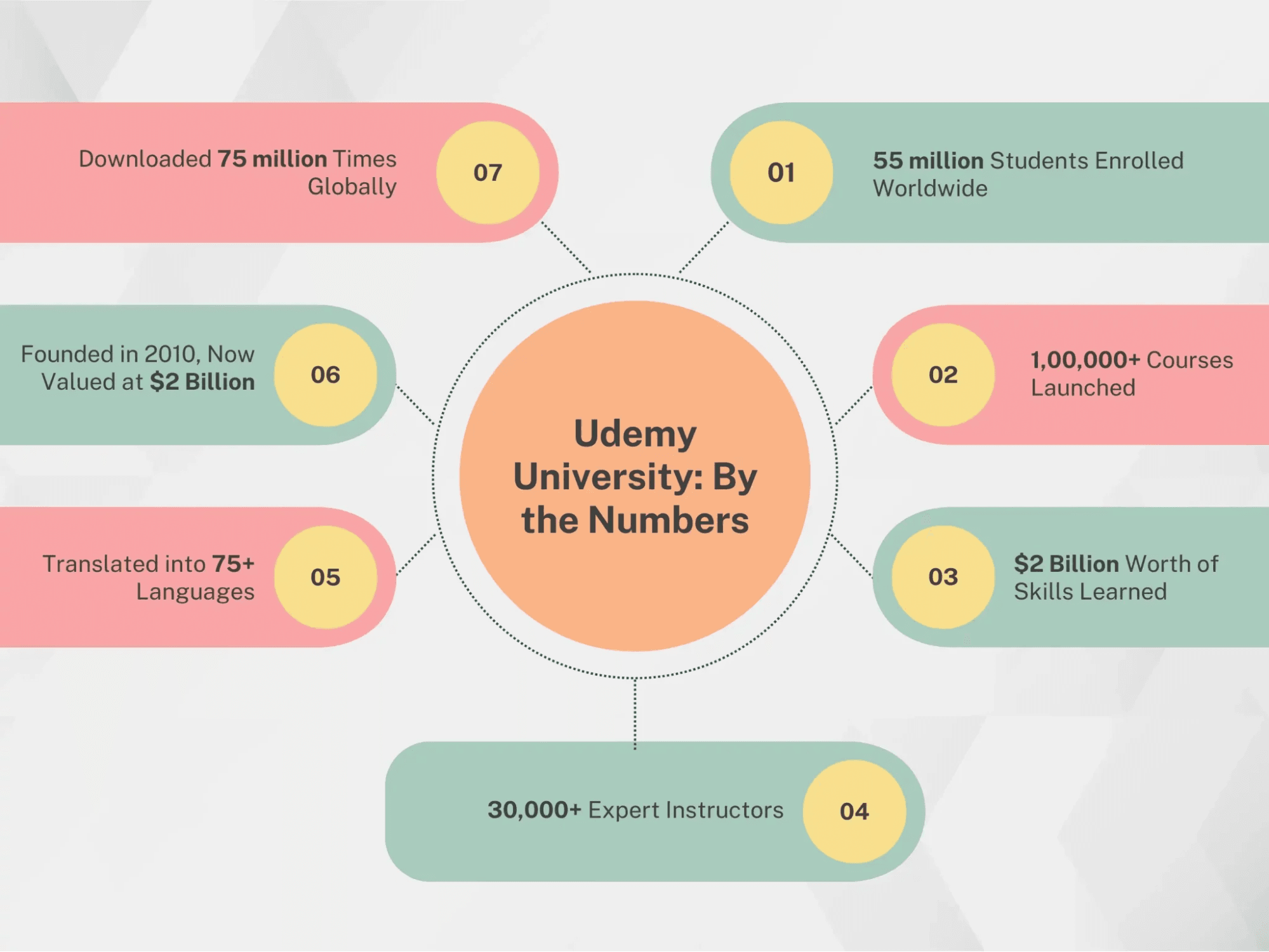
Revenue Sources
Udemy stands out from competitors by offering students ease and comfort in exploring a diverse range of online courses in their preferred languages. These courses, taught by experts worldwide, are available at affordable prices.
Udemy generates revenue through various channels, primarily by sharing revenue with instructors based on course sales. This revenue-sharing model ensures instructors are compensated for their content while Udemy earns through course sales on its platform.
Why build an eLearning App like Udemy?
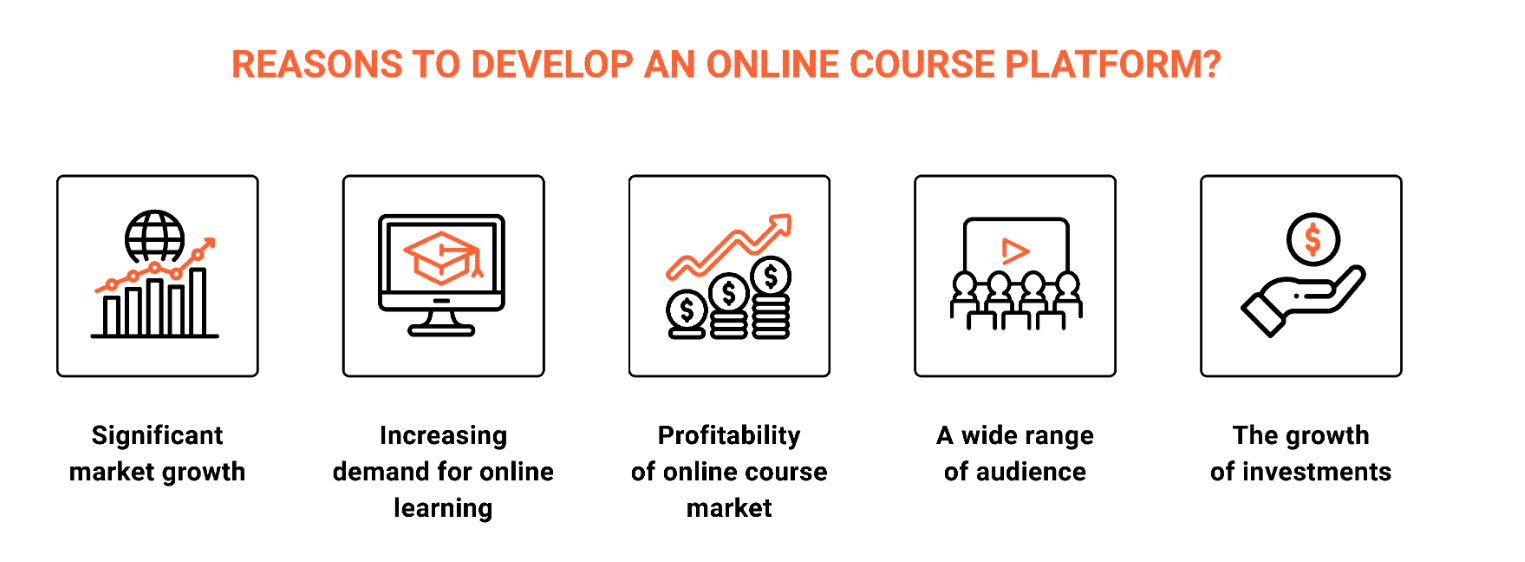
1. Affordable
Quality education from schools and colleges can be expensive, limiting access for many. eLearning apps like Babbel, Duolingo, Coursera, and Udemy capitalized on this by offering affordable educational options. Their smart pricing strategies grabbed users’ curiosity and interest, making education more accessible and appealing to a broader audience.
2. Target Wide Audience
Traditional educational institutions often target specific age groups, leaving others, like adults wanting to learn new skills, feeling left out. eLearning has resolved this issue by offering flexible, online education accessible to all, regardless of age or schedule. This inclusivity has enabled professionals to acquire new skills conveniently. Moreover, eLearning platforms can reach a broader audience than traditional institutions, leading to significant revenue opportunities.
3. Personalized Learning
One of the main reasons users love platforms like Udemy is their personalized learning approach, which embodies the essence of edtech. Unlike traditional schools, these platforms use artificial intelligence to tailor the learning experience, customizing content to individual needs. This personalization enhances learning effectiveness and retention, making the process more engaging and relevant.
4. Increase Revenue
Given the current market growth, now is the ideal time to build an eLearning website like Udemy. Businesses are increasingly investing in app development to generate significant revenue, and eLearning platforms are no exception. The education market has immense potential for profitability. By creating a successful eLearning platform and targeting the right audience, you can potentially earn millions or even billions.
5. Learn At Your Own Pace
One of the biggest advantages of platforms like Udemy is self-paced learning. Professional and school courses on these platforms allow users to learn at their own pace, without the pressure of a strict schedule. They can re-watch videos whenever convenient, enabling them to grasp topics more thoroughly and gain in-depth knowledge. Therefore, investing in a feature-rich solution from a mobile app development company to create an app like Udemy is a smart move.
6. Incredible Market Growth
The online education industry is booming, supported by impressive statistics. The rapid growth of the online course market highlights the immense potential and opportunity, making it a smart decision to enter this industry without hesitation.
7. Phenomenal Demand
Universities, colleges, schools, and individuals are rapidly moving online due to its numerous benefits. This showcases the importance of launching a robust online learning platform like Udemy or Coursera to capitalize on this growing trend.
8. Digital connectivity
Massive Open Online Courses or MOOCs have revolutionized learning, offering easy access to vast knowledge resources. An app with this information can facilitate seamless learning, enabling collaboration, discussions, and personalized learning experiences. With one-click access and twenty-four seven availability, learners can engage with their chosen topics at their convenience, making learning both accessible and enjoyable.
9. Communication gets easier
Apps improve communication between students, teachers, and parents. With chat features, teachers are accessible anytime to provide guidance. This enhances connectivity and removes communication barriers, enabling stakeholders to connect seamlessly.
10. Enhance Data Management
Mobile apps revolutionize data management for educators by enabling seamless resource upload and personalized learning experiences through data collection. This bi-directional approach facilitates tracking individual student progress and tailoring support and resources accordingly. As a result, learners receive targeted assistance while educators gain valuable insights to enhance engagement and foster loyalty. Apps thus establish a mutually beneficial partnership between educators and learners, optimizing the learning experience for all involved.
11. Simplify business operations
Mobile apps assist educators in optimizing business operations and boosting staff efficiency. Education apps utilize device features to gather user data, enhancing personalized learning experiences. Automated workflows reduce errors and improve collaboration, managing tasks like attendance and fee collection seamlessly through payment gateways.
12. Apps minimzes barriers to Learning
Traditional learning methods have limitations, like geographical or financial barriers. A mobile app can break these barriers, serving as a digital bridge. Students can learn from instructors worldwide, access resources anytime, and schedule classes conveniently, enhancing flexibility and access to education.
Functions of Udemy App or Website
1. Find out Your Hidden Skills
Udemy offers a diverse range of courses uploaded by professionals worldwide, catering to various interests and skill levels. Whether it’s technical skills for coders, sports coaching, or any other interest, learners can find a course to pursue their passions and enhance their expertise on the platform.
2. Learn on Your Schedule
The app offers a hassle-free experience, eliminating the need for attendance rush. Users can select their study time, take virtual notes, complete exercises at their own pace, save or download notes as needed, and collaborate with tutors when necessary, providing a flexible and convenient learning environment.
3. Affordable Online Courses
Udemy offers pocket-friendly courses with frequent discounts and offers, sometimes available for as low as $10. This affordability encourages users to become permanent learners on the platform, ensuring ongoing engagement and loyalty.
4. Instant Certification Upon Completion
Udemy collaborates with a range of educational institutions and organizations to offer certification courses that provide practical knowledge to learners. This partnership ensures access to high-quality certification programs both online and offline, making it easier for users to find the best courses suited to their needs.
Features To Add To Your eLearning App
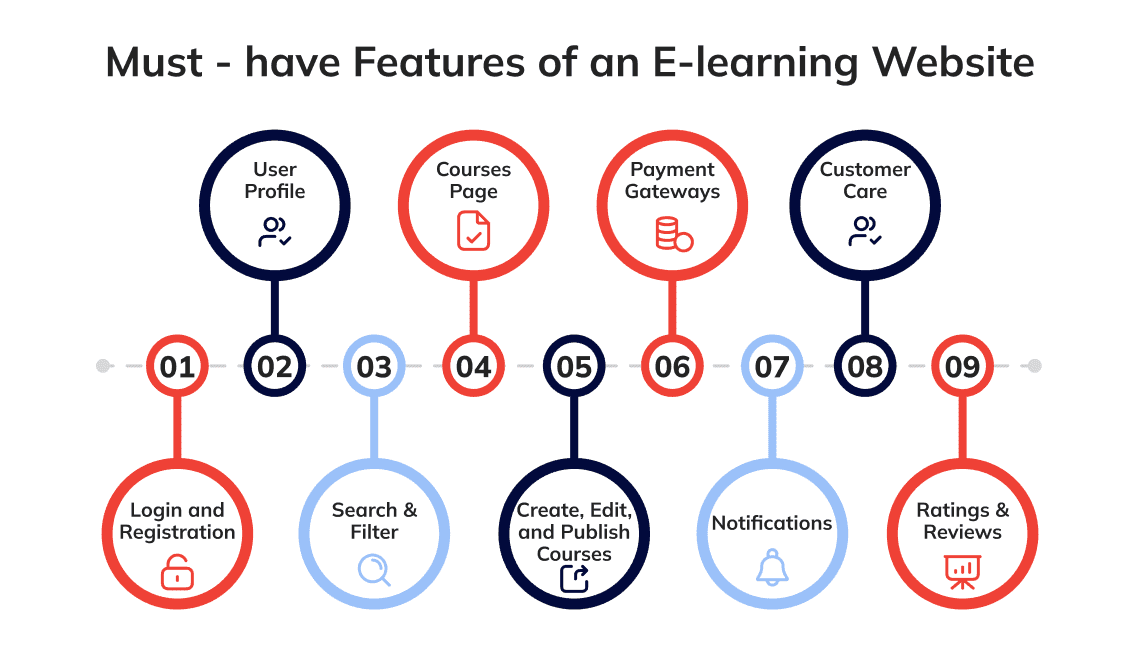
General Features
1. Organized Course Categories
This aspect is crucial as it ensures that your students have a clear understanding of the courses available to them, including both paid and free course options.
2. Timely Push Notifications
This feature is crucial as it allows both students and teachers to receive important updates through push notifications about new courses, discounts, deals, and more, ensuring they stay informed and engaged.
3. Wide Range of Courses
Just like Udemy provides a diverse array of courses spanning from music to science, your platform can also offer a wide range of learning opportunities to cater to various interests and preferences. Partnering with top mobile app development services can help bring this vision to life for your learners.
4. User Feedback and Reviews
This functionality enables a deeper understanding of your students’ preferences, allowing you to tailor learning experiences accordingly. Students can provide feedback and reviews for courses, fostering a personalized learning environment that enhances engagement and satisfaction.
5. Hassle-Free Sign-Up
Similar to Udemy’s comprehensive course selection covering topics from music to science, your platform can also provide a diverse range of learning opportunities tailored to different interests. Collaborating with leading mobile app development services can help transform this vision into reality for your learners.
6. Integrated Payment Options
Leverage efficient mobile application services to seamlessly integrate social media profiles into your eLearning app. This streamlines the registration process, allowing students to sign up effortlessly and access your platform with ease.
7. Multilingual Support
To attract a global audience to your eLearning website or app, ensure you offer multiple language options. This allows users to enroll in courses in their preferred language, making learning more accessible and convenient for everyone.
8. Fair Refund Policy
Many eLearning websites provide a money-back guarantee for students who decide not to continue, typically charging only a minimal registration fee. Implementing a similar money-back policy on your platform can help reassure students of the quality of your content and build their trust in your service.
9. 24/7 Customer Support
Partner with an on-demand app development company to provide round the clock customer support for your clients. Effective customer assistance is essential, as it not only aids your customers but also fosters stronger relationships, ultimately benefiting your business.
Other Add-on Features for Students and Faculties
1. Filter
A filter feature enables students to sort subjects based on their preferences and requirements. They can easily distinguish between free and paid courses and categorize subjects according to their interests, making course selection more efficient.
2. Sleek Dashboard
The teacher’s feature offers an intuitive dashboard that allows instructors to monitor learners’ online activities effortlessly. Instructors can also rate students enrolled in paid courses directly from this dashboard. Additionally, the dashboard provides insights into the traffic and conversion rates of their courses, helping instructors understand engagement and performance. All these functionalities are streamlined into a single, user-friendly dashboard, minimizing confusion and enhancing the efficiency of course management and evaluation.
3. Course Recommendation
Every sector is integrating fast-paced technologies into their workflows. Artificial intelligence is shaping the education sector in a whole different manner. Connect with an eLearning solutions provider to incorporate AI into your learning portal. This will offer your learners smart suggestions and course recommendations, allowing them to enroll in multiple courses based on these tailored recommendations.
How to Create an eLearning App/Website Like Udemy?
Creating an eLearning website involves more than just development; it encompasses several steps in the production cycle of eLearning mobile apps and websites like Udemy. This process starts with thorough groundwork, including market analysis, identifying target audiences, and defining the scope of courses. Next, the design phase focuses on creating an intuitive and engaging user interface.
Development follows, involving both front-end and back-end work. Post-development, rigorous testing ensures functionality and user experience. Finally, the business creation level involves marketing strategies, establishing partnerships, and continuous improvement based on user feedback to ensure long-term success.
Let’s have a look at the process in detail!
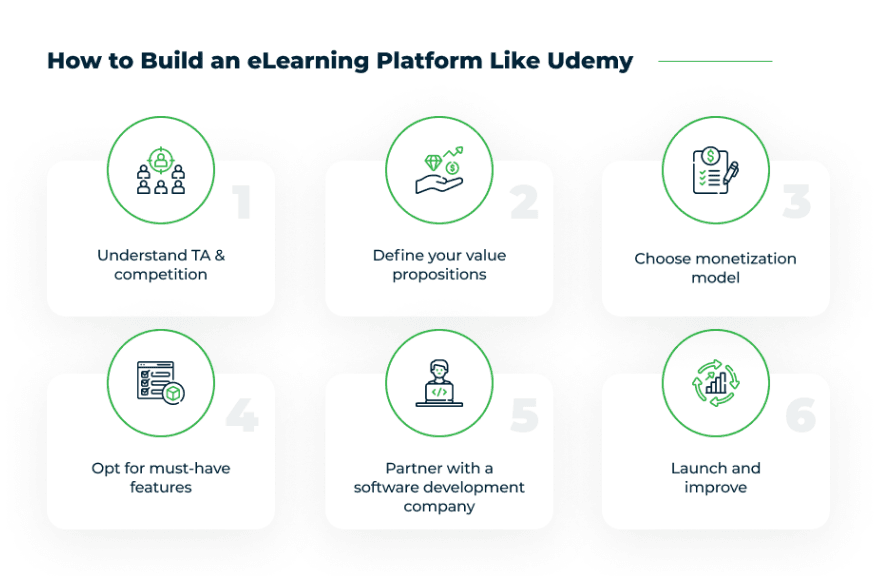
1. Define Your Niche
Target region:
Have you analyzed the market where you will launch your eLearning website? If not, start now. Identify a state, country, or neighborhood lacking online learning platforms. It’s not just about offering courses but also about competitive tuition fees. An eLearning website with a lower subscription fee can attract more users. If you succeed locally, expanding to urban regions can become a strategic future plan.
Target audience:
When researching the online education marketplace, it’s crucial to identify your target audience. It’s not just students but also employees, freshers, teachers, and enthusiastic learners who might opt for paid and free courses. Answer these questions to better understand your audience:
- Who will use your online learning platform?
- Is your focus on students, teachers, employees, or enthusiastic learners?
- What is the age range of users opting for online courses?
- What are your users’ goals – upgrading skills or exchanging knowledge?
- Are you aiming for vertical or horizontal growth in your business model?
- What language does your target audience prefer?
- What pain points can your eLearning website and app address?
- How interactive is your eLearning website for users?
These questions will help you better understand your audience before launching your eLearning website in the online education marketplace.
Target course:
After analyzing your user persona, it’s time to focus on the specific online courses you want to launch initially and develop them as your Unique Selling Proposition (USP).
- Will your platform offer machine learning courses like Udemy?
- Are you providing online education in fields such as pharmacology, astrology, and psychology?
- Are you creating courses that refresh the learner’s mind?
- Will you incorporate gamification in courses to motivate learners?
- Will your online courses cater to sports lovers, offering insights into sports technologies and digital transformation?
Remember how Udemy started? Launched in 2010 with limited courses, Udemy quickly expanded to 2,000 courses created by 1,000 instructors, attracting 10,000 users within a few months.
2. Unique selling feature
There are various types of online learning platforms operating on different models. Websites like Udemy have a USP rooted in their extensive course catalog. With over 100,000 courses covering basic to advanced topics, Udemy makes learning accessible and easy to understand for everyone. Their one-time payment model also makes courses very affordable. Choosing the right USP is crucial for success; a strong, unique concept can lead to unlimited growth, while a poorly chosen USP can result in failure. Developing a unique concept for your website, similar to Udemy, is essential.
MOOCs:
MOOCs, or Massive Open Online Courses, are free online courses accessible to everyone without requiring regular attendance or limited access. These courses allow both students and teachers to enroll, providing unlimited access to a wide range of online courses on various subjects. This flexibility makes MOOCs an excellent resource for continuous learning and skill development, regardless of location or schedule.
Virtual Learning environment:
A Virtual Learning Environment (VLE) is a collaborative platform designed for conference sessions, class discussions, and progress tracking. It simulates a physical classroom experience, enabling learning, questioning, homework, and conversations to occur in an organized manner. Both teachers and students can monitor their progress within the VLE, which fosters continuous academic or knowledge-based growth. This structure ensures a well-rounded, interactive, and efficient educational experience.
Video Streaming online learning:
Video streaming in eLearning refers to delivering courses through video content rather than just video calls. Studies show that visual media enhances knowledge retention. By incorporating video streaming, tutors can upload and teach courses effectively, and students can enroll to watch these videos, providing a more engaging and efficient learning experience. This method leverages the power of visual learning for better knowledge acquisition.
Gamification:
Hypothetically, online classes can sometimes become monotonous without engaging elements. This is where gamification comes in, adding entertainment and challenging tasks that not only test skills but also motivate learners through enjoyable activities. Courses with gamification often see higher enrollment compared to conventional ones. Integrating advanced technologies like VR, AI, and data science can further enhance the learning experience, making your eLearning website and app more appealing and effective, thus boosting your idea significantly.
3. Implementation of development
After planning, the next step is web and mobile app development. Key considerations include selecting the right development partner, maintaining a flexible budget, setting realistic timelines, and managing complexity. Whether you’re a developer or entrepreneur, understanding these elements will help you navigate the eLearning app development process from scratch.
UI/UX Designing
UI/UX design is crucial for attracting and retaining users on web and mobile apps. A well-crafted UI includes appealing color schemes, icons, direct text, animations, and other elements that create a visually engaging experience. On the other hand, UX focuses on smooth interaction and navigation, enhancing user satisfaction. Tools like Figma, Adobe XD, Illustrator, and Axure are commonly used for designing effective UI/UX, making them vital for successful eLearning platforms.
eLearning Website/Application Development
After UI/UX design, developers must transform these designs into functional applications. Basic tech knowledge isn’t enough; even intermediate coders should consider Udemy courses for advanced skills to avoid pitfalls during coding. Let’s get started.
Step 1: The website’s user interface, deployed with HTML, CSS, and JavaScript, along with frameworks like React.js, Angular, or Vue.js, forms the front end. This is where users directly interact with the interface.
Step 2: App development can be native or hybrid, each requiring a different tech stack. Native Android apps use Android Studio, while native iOS apps are deployed with Swift code. Hybrid apps, like those built with Flutter, React Native, PhoneGap, or Xamarin, streamline development by allowing code to run on multiple platforms.
Step 3: Server-side development, also known as back-end development, involves coding the features that make a web app functional. This includes managing databases, scripts, and website architecture. Back-end developers use technologies like Core PHP, Laravel, Ruby, Java, Python, etc., to build the server-side functionality of websites and applications.
Step 4: Database integration is essential for data collection. Technologies like MongoDB, MySQL, Oracle, and NoSQL are commonly used for storing various types of data such as videos, personal information, courses, and images.
Step 5: Utilizing cloud services, particularly SAAS, is crucial for efficient app operation. Deploying physical servers can be cumbersome, requiring extensive maintenance and incurring unnecessary costs. Cloud servers offer flexibility and cost-effectiveness, allowing payment based on usage.
Step 6: Integrating a payment gateway within your application ensures a seamless and secure transaction process, enhancing user trust and retention. Avoiding redirection to external platforms for payments maintains user engagement and convenience.
Partnering with a custom software development company can be beneficial in carrying out the development process, allowing you to give priority to business objectives while trading on the expertise of experienced developers. Their insights into market demands and emerging features ensure that your eLearning website and app meet industry standards and user expectations.
4. Testing/QA
Ensuring a seamless user experience is crucial for the success of any mobile app. Before launching, thorough testing by quality analysts is imperative to identify and rectify any bugs or glitches. Both manual and automated tests should be conducted to guarantee optimal functionality and performance. Addressing issues such as slow response times or difficulty in operation prior to release helps retain users and prevent negative impact on business reputation and customer retention.
5. Launching
After launching the website and app, the focus shifts to executing the business model. Market analysis has laid the groundwork, now it’s time to set a launch date and initiate targeted marketing campaigns. These efforts aim to raise awareness among the target audience about the eLearning platform. Effective execution of the business plan ensures a successful transition from development to operations, driving user engagement and growth.
How Much Does eLearning App Development Costs?
Developing an eLearning app similar to Udemy can cost between $50K and go up to $150K, depending on what features you want. You’ll need to hire an expert eLearning software development company to handle everything from how the app looks and works to how payments are processed. Basic features may be accomplished within a 50,000 budget, while a comprehensive app with advanced features could extend up to $150K in expenses.

Factors Affecting the Cost to Build an eLearning Website like Udemy
1. Key Features
To develop a platform like Udemy, incorporating basic features such as search functionality, user management, course listings, video streaming, and payment processing incurs lower costs. However, integrating advanced features like AI, gamification, or advanced analytics can increase expenses. Balancing features with budget constraints is crucial for cost-effective development.
2. Development Team Location
When hiring mobile developers for your online education platform like Udemy, consider the region’s living standards, as developers from countries with higher living costs, such as the USA, may charge more compared to developers from regions like Asia. This choice can significantly impact your overall development costs.
3. UI/UX Design Excellence
Consider how your users will feel when they use your app or website. A simple and easy-to-use design is better than a complicated one. It not only saves money but also makes users happier. So, focus on making it easy for them to use.
4. Innovative Development Approach
You have options for building a platform like Udemy: do it in-house, hire freelancers, or outsource to a mobile app development company. We recommend outsourcing because it’s cheaper and you get quality work. Now, let’s discuss how you can make back the money you invested.
You may like to read: E-Learning App Development: A Complete Guide on Types, Features, and Cost!
Monetization Models to Create an Online Education Platform like Udemy
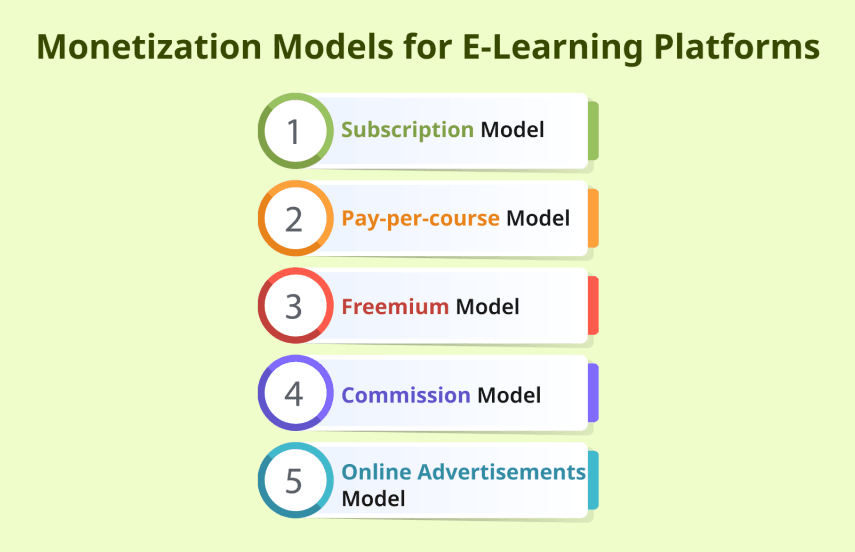
So, if you have decided to launch your online education portal like Udemy. But what’s next? Well, it’s obviously money! How are you going to get through this platform? Let’s discuss some of the monetization strategies available in the market.
1. Freemium
A popular education app business model combines free and premium offerings. Provide limited free courses to attract users, and charge for premium features like certificates, exclusive courses, or instructor interaction. Stay competitive by integrating new education technology trends into premium features, encouraging users to subscribe.
2. Corporate Training Model
An educational app provides a dynamic and engaging learning experience. By partnering with businesses, you can offer customized training programs or courses for their employees. This model can generate high revenue through bulk deals, targeting specific markets with unique needs.
3. Subscription Model
Users pay a monthly or annual subscription fee for unlimited course access, providing consistent revenue and encouraging user retention. By integrating exceptional features, you can establish recurring revenue streams while promoting user loyalty and increased content consumption.
4. Paid Course Model
This model is popular among eLearning platforms like Udemy. Instructors create and upload courses, set their prices, and you earn a share of their revenue per enrollment. It’s an effective way to establish your app as a provider of high-quality content and generate revenue.
This concludes our guide to creating a platform like Udemy.
How DianApps Can Help to Create a Platform Like Udemy?
For starting your journey of developing a Udemy-like platform, DianApps is your ideal e-learning app development company.
What do DianApps’ eLearning development solutions look like?
- Learning management system
- Education Portals
- Knowledge Bases
- M-learning Solution
- Custom Testing
- Reporting & Analytics
- Talent Development Systems
- Custom Simulators
Our Expertise
- Virtual Classroom
- Online Training
- Education Games
- Corporate Training
Why Choose DianApps?
- Latest Technology
- Personalization
- Round The Clock Service
- Performance Support Tools
- Mobility Solutions
- Advanced Learning Experience
We prioritize client goals, ensuring exceptional results that drive user engagement and business growth. Through collaborative development, we ensure clear communication and client involvement at every step. Have an idea? Contact us to turn it into a successful product.
That’s a Wrap
Before starting off, conduct thorough market research to understand competitors and your target audience. This insight is crucial for successful app development. Additionally, visualize the ideal design and layout for your product. For expert assistance, consider partnering with top mobile app development companies like DianApps. Our expertise ensures complete support throughout the development process. With proper planning and collaboration, you’ll be well-equipped for successful eLearning app development. Good luck!


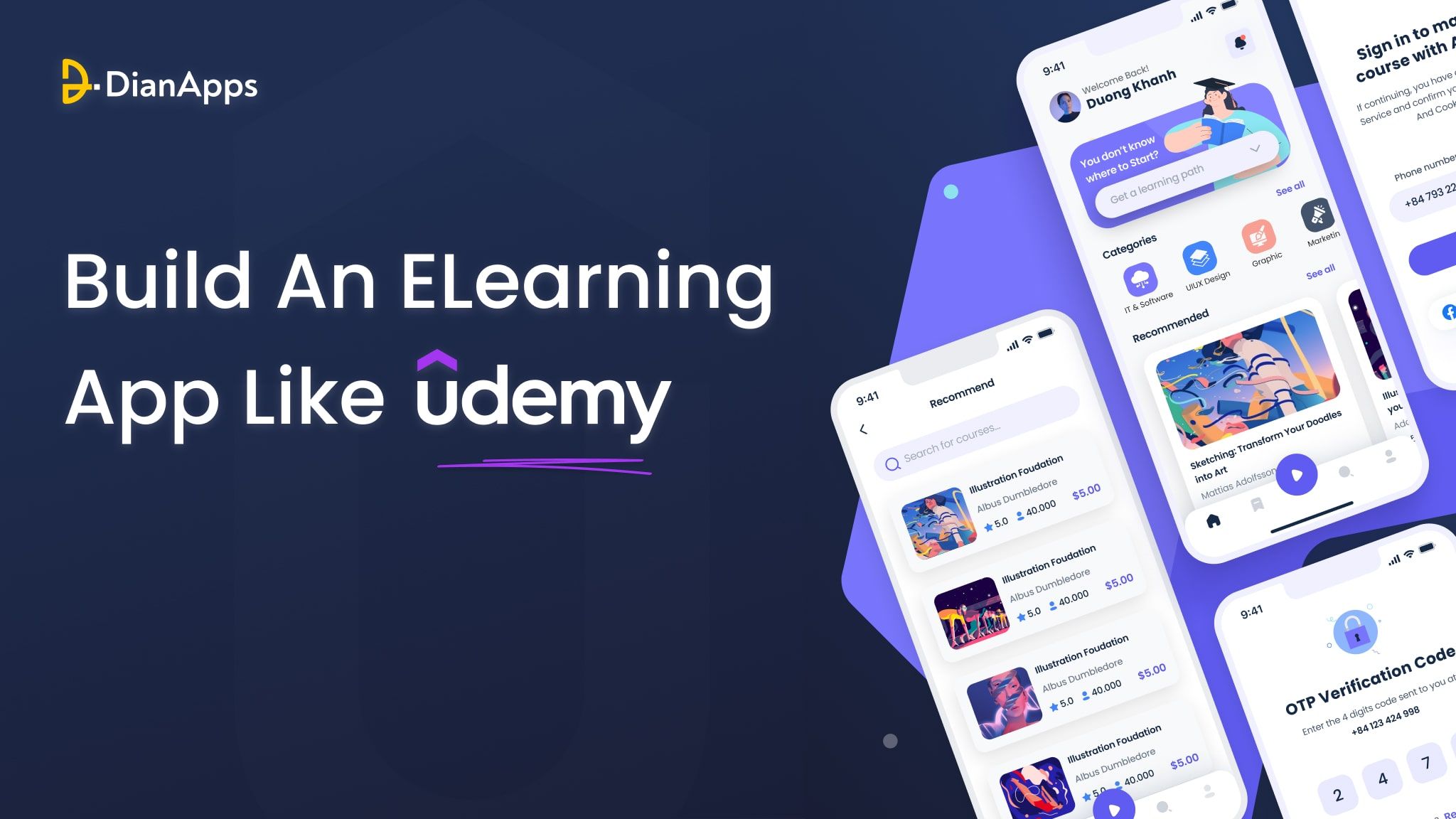







Leave a Comment
Your email address will not be published. Required fields are marked *